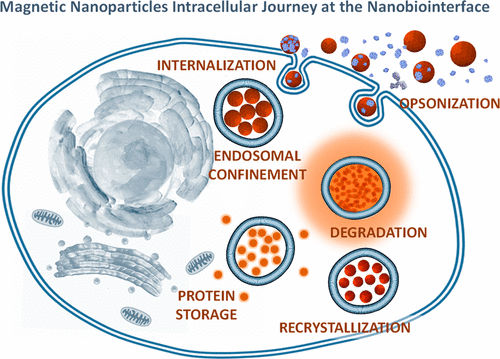当前位置:
X-MOL 学术
›
Acc. Chem. Res.
›
论文详情
Our official English website, www.x-mol.net, welcomes your
feedback! (Note: you will need to create a separate account there.)
Ever-Evolving Identity of Magnetic Nanoparticles within Human Cells: The Interplay of Endosomal Confinement, Degradation, Storage, and Neocrystallization.
Accounts of Chemical Research ( IF 16.4 ) Pub Date : 2020-09-16 , DOI: 10.1021/acs.accounts.0c00355 Aurore Van de Walle 1 , Jelena Kolosnjaj-Tabi 2 , Yoann Lalatonne 3, 4 , Claire Wilhelm 1
Accounts of Chemical Research ( IF 16.4 ) Pub Date : 2020-09-16 , DOI: 10.1021/acs.accounts.0c00355 Aurore Van de Walle 1 , Jelena Kolosnjaj-Tabi 2 , Yoann Lalatonne 3, 4 , Claire Wilhelm 1
Affiliation

|
Considerable knowledge has been acquired in inorganic nanoparticles’ synthesis and nanoparticles’ potential use in biomedical applications. Among different materials, iron oxide nanoparticles remain unrivaled for several reasons. Not only do they respond to multiple physical stimuli (e.g., magnetism, light) and exert multifunctional therapeutic and diagnostic actions but also they are biocompatible and integrate endogenous iron-related metabolic pathways. With the aim to optimize the use of (magnetic) iron oxide nanoparticles in biomedicine, different biophysical phenomena have been recently identified and studied. Among them, the concept of a “nanoparticle’s identity” is of particular importance. Nanoparticles’ identities evolve in distinct biological environments and over different periods of time. In this Account, we focus on the remodeling of magnetic nanoparticles’ identities following their journey inside cells. For instance, nanoparticles’ functions, such as heat generation or magnetic resonance imaging, can be highly impacted by endosomal confinement. Structural degradation of nanoparticles was also evidenced and quantified in cellulo and correlates with the loss of magnetic nanoparticle properties. Remarkably, in human stem cells, the nonmagnetic products of nanoparticles’ degradation could be subsequently reassembled into neosynthesized, endogenous magnetic nanoparticles. This stunning occurrence might account for the natural presence of magnetic particles in human organs, especially the brain. However, mechanistic details and the implication of such phenomena in homeostasis and disease have yet to be completely unraveled.
中文翻译:

人类细胞内磁性纳米粒子的不断发展的身份:内体限制,降解,储存和新结晶的相互作用。
在无机纳米颗粒的合成以及纳米颗粒在生物医学应用中的潜在用途方面已经获得了相当多的知识。在不同的材料中,由于多种原因,氧化铁纳米粒子仍然无可匹敌。它们不仅对多种物理刺激(例如,磁力,光)作出反应并发挥多功能的治疗和诊断作用,而且具有生物相容性,并且整合了内源性铁相关的代谢途径。为了最优化(磁性)氧化铁纳米粒子在生物医学中的使用,最近已识别和研究了不同的生物物理现象。其中,“纳米粒子身份”的概念尤为重要。纳米粒子的身份在不同的生物环境中和不同的时期内进化。在这个帐户中,我们着重研究磁性纳米粒子在细胞内的迁移后的身份重塑。例如,纳米颗粒的功能,例如生热或磁共振成像,会受到内体限制的高度影响。纳米颗粒的结构降解也得到了证明和量化在纤维素中并与磁性纳米粒子特性的丧失有关。值得注意的是,在人类干细胞中,纳米粒子降解的非磁性产物可以随后重新组装成新合成的内源磁性纳米粒子。这种惊人的现象可能解释了人体器官(尤其是大脑)中磁性粒子的自然存在。然而,机制细节以及这种现象在动态平衡和疾病中的含意尚未完全阐明。
更新日期:2020-10-21
中文翻译:

人类细胞内磁性纳米粒子的不断发展的身份:内体限制,降解,储存和新结晶的相互作用。
在无机纳米颗粒的合成以及纳米颗粒在生物医学应用中的潜在用途方面已经获得了相当多的知识。在不同的材料中,由于多种原因,氧化铁纳米粒子仍然无可匹敌。它们不仅对多种物理刺激(例如,磁力,光)作出反应并发挥多功能的治疗和诊断作用,而且具有生物相容性,并且整合了内源性铁相关的代谢途径。为了最优化(磁性)氧化铁纳米粒子在生物医学中的使用,最近已识别和研究了不同的生物物理现象。其中,“纳米粒子身份”的概念尤为重要。纳米粒子的身份在不同的生物环境中和不同的时期内进化。在这个帐户中,我们着重研究磁性纳米粒子在细胞内的迁移后的身份重塑。例如,纳米颗粒的功能,例如生热或磁共振成像,会受到内体限制的高度影响。纳米颗粒的结构降解也得到了证明和量化在纤维素中并与磁性纳米粒子特性的丧失有关。值得注意的是,在人类干细胞中,纳米粒子降解的非磁性产物可以随后重新组装成新合成的内源磁性纳米粒子。这种惊人的现象可能解释了人体器官(尤其是大脑)中磁性粒子的自然存在。然而,机制细节以及这种现象在动态平衡和疾病中的含意尚未完全阐明。











































 京公网安备 11010802027423号
京公网安备 11010802027423号